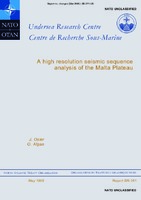| dc.description.abstract | A high resolution seismic study of the Malta Plateau was conducted to characterize the Quaternary sediment layers, mapping their regional extent and determining the environmental conditions during their deposition. Seismic stratigraphic analysis indicates that there are six seismic units (or depositional sequences) bounded by erosional unconformities. The basement surface, that is an erosional truncation in some places, indicates that a hiatus probably occurred during Messinian to Early Pliocene. The terminations of all the sequence boundaries onlap the acoustic basement in a landward direction, revealing an overall relative sea level rise. The termination of the internal strata (reflectors) in Units 2, 3 and 4 have an oblique parallel pattern and toplap at their upper surface, characteristic of periods of sea level stillstand and/or a decrease in the rate of sea level rise. It is anticipated that this depositional history would cause the physical properties of the sediment in the immediate vicinity of the erosional unconformities to differ from that in the adjacent sequences. Within a given sequence and with respect to the other sequences, it is anticipated that the physical properties of the sediment are relatively homogeneous, with the exception of the uppermost sequence, Seismic Unit 1. Carbonate buildup structures are observed at the boundary between Units 2 and 3 in the northwest part of the study area and imply a very shallow water depositional condition during their formation. The uppermost layer, Unit, 1, is the most extensive geographically and gets thicker towards the coast of Sicily. The parallel configuration of its internal reflectors and the progradational character of the unit suggest that it is comprised of coastal sediments deposited during the Holocene highstand of sea level. In the shelf-slope transition, sequences are deformed by mass movements that might be attributable to tectonic activity in the region. Several basement outcrops were observed in the study area. Some have northwest-southeast trending lineations, as observed on Sicily, while others are isolated structures, possibly dikes or salt domes. | |
